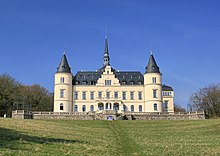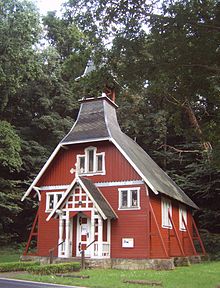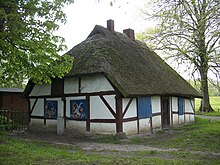Ralswiek
| coat of arms | Germany map | |
|---|---|---|

|
Coordinates: 54 ° 28 ' N , 13 ° 27' E |
|
| Basic data | ||
| State : | Mecklenburg-Western Pomerania | |
| County : | Western Pomerania-Ruegen | |
| Office : | Mountains on Rügen | |
| Height : | 1 m above sea level NHN | |
| Area : | 16.53 km 2 | |
| Residents: | 245 (Dec. 31, 2019) | |
| Population density : | 15 inhabitants per km 2 | |
| Postal code : | 18528 | |
| Area code : | 03838 | |
| License plate : | VR, GMN, NVP, RDG, RÜG | |
| Community key : | 13 0 73 072 | |
| Office administration address: | Markt 5–6 18528 Bergen on Rügen |
|
| Website : | ||
| Mayor : | Herbert Knüppel | |
| Location of the municipality of Ralswiek in the district of Vorpommern-Rügen | ||
Ralswiek is a German municipality in the district of Vorpommern-Rügen on the island of Rügen in Mecklenburg-Western Pomerania . The municipality is administered by the Bergen auf Rügen office based in the city of the same name .
geography
The municipality of Ralswiek is located around eight kilometers north of Bergen on Rügen, a little off the highway 96 and the Stralsund – Sassnitz railway line at the southernmost point of the Great Jasmunder Bodden , a lagoon in the Baltic Sea . Ralswiek includes the districts Augustenhof, Gnies and Jarnitz, as well as Sabitz .
history
Archaeological excavations show that the region around Ralswiek was already settled in the late Mesolithic around 8000 years ago ( Lietzow culture ). About 3 km northeast of Ralswiek, on the steep slope of the northeastern end of the Black Mountains, are the remains of the Schlossberg , a probably Bronze Age defense system.
The place name "Ralswiik" was first mentioned in 1311. The meaning of the name is controversial, it could be derived from a Slavic personal name or from the Danish word ral (gravel). The ending wiek is a typical Nordic name for places that are on a bay or have a port.
The place was founded in the 8th century by the West Slavic Rans as a seaport . In addition to Charenza and the temple castle on Cape Arkona , Ralswiek was the most famous town ( civitas ) of the Ranen on the island.
Today's small Ralswiek was one of the important ports on the Baltic Sea in the Middle Ages . The extensive trade relations that existed with other port cities on the Baltic Sea are evidenced by archaeological finds of soapstone bowls from Norway and hip-handle vessels made in Sweden. Arabic dirhem and Persian drachmas indicate trade relations as far as the Pontic region. A coin find of Arabic 2,203 dirhem, minted between 459 and 847 AD, is now on display in the cultural history museum in Stralsund.
The four boats up to 14 meters long and 3.40 meters wide , which were discovered during excavations between 1967 and 1980, are historically interesting . They document a history of seafarers and traders with trade relations on the routes of the Vikings, who also lived and were buried here (grave finds with additions).
House floor plans, a port facility, a cult site and a total of more than 12,000 finds on an area of over 1500 m² complete the picture of a medieval settlement that was of similar importance to the area around Rügen as Haithabu in Schleswig-Holstein, Wolin in Poland or Menzlin in Western Pomerania .
From the Slavic period from the 8th to the 12th century, there is a burial mound with around 400 hills on the terminal moraines northeast of Ralswiek.
After the conquest and Christianization of Rügen by the Danes in 1168, the place came into the possession of the Lund diocese and became the ecclesiastical administrative center for the island. The former provost building still bears witness to this today, with remains of Gothic architecture from around 1400.
In 1480 the ecclesiastical bailiffs were replaced by secular bailiffs, the first bailiff was a von Normann and from 1500 a von Barnekow . His family was hereditary with Ralswiek after the Reformation in 1536, when the church property was abolished. The fiefdom was withdrawn in 1637 after Sweden took over Pomerania. In 1656 the King of Sweden handed over the property to Field Marshal Count Carl Gustav Wrangel. After his death, the property was transferred in 1676 to General Otto Wilhelm Graf Königsmarck, who died in 1679. Ralswiek now came back to von Barnekow's.
In March 1976, children from nearby Patzig in the forest near Ralswiek made a sensational find, they hid an ornate iron box with gold jewelry, which the University of Greifswald suspected to be jewelry of Queen Christine of Sweden.
In 1891 the estate was sold to the family of the manufacturer Hugo Sholto Graf Douglas from Aschersleben . From 1893 to 1896 he had a palace designed by the Berlin architect G. Stroh based on the model of French Renaissance palaces. The castle consists of the main building, the stables and an intermediate wing built later. After 1894, a park around the palace that had existed since 1800 was redesigned into a landscape park with many dendrologically significant trees. In 1907 the small wooden chapel in Ralswiek was built .
In 1939 the property was expropriated with compensation and used as a casino for the local naval port. As a Nazi Reich property, it was expropriated in 1945 and the castle housed an old people's home for many years. Then the German Red Cross ran a home for the disabled in him. In 1999 the conversion to a hotel began.
Since 1818 Ralswiek has belonged to the district of Rügen . Territorial reforms changed Ralswiek's affiliation as follows: 1952–1955 - District of Bergen 1955–1990 - District of Rügen in the district of Rostock, from 1990 part of the state of Mecklenburg-Western Pomerania 2011 - Association for the district of Western Pomerania-Rügen
The place lost almost ten percent of its population in 2007.
politics
coat of arms
The coat of arms was approved by the Ministry of the Interior on March 6, 1999 and registered under the number 183 of the coat of arms of Mecklenburg-Western Pomerania.
Blazon : “Divided; above, in silver, a red ship of Nordic design moving to the left; below in green a silver mug with the opening to the right with a handle on top. "
The coat of arms was designed by Jörg Korkhaus from Bergen .
flag
The municipality's flag is uniformly green and white with vertical stripes. In the middle, at two thirds of the height of the green and white stripes, is the coat of arms of Ralswiek. The length of the flag cloth is related to the height as 5: 3.
Sights and culture

- Störtebeker Festival in Ralswiek every year since 1993 on a natural stage. 1959–1961 and 1980–1981 the dramatic ballad Klaus Störtebeker by Kurt Barthel was performed here.
- Ralswiek Castle above the Großer Jasmunder Bodden built for Hugo Sholto Graf Douglas until 1896; today a hotel. It is surrounded by a garden in the neo-renaissance style.
- The old Swedish wooden chapel Ralswiek from 1907.
- Dat olle Schoolhus was made available for school lessons in 1872 by the patroness Auguste von Barnekow at Dorfstraße 12, later expanded with a class extension and used as a school until after 1945. Today it houses holiday apartments.
- Slavic barrows in the Black Mountains from the 12th century northeast of Ralswiek.
- Jarnitz manor house for the Count Douglas and von Massow family from 1780; Two-storey plastered building with hipped roof , changed several times and renovated in 2002.
Individual evidence
- ↑ Statistisches Amt MV - population status of the districts, offices and municipalities 2019 (XLS file) (official population figures in the update of the 2011 census) ( help ).
- ^ Lehmann / Meyer, "Rügen AZ", Wähmann-Verlag, Schwerin, 1976, p. 64
- ^ Hubertus Neuschäffer: Western Pomerania's castles and mansions . Husum Druck- und Verlagsgesellschaft 1993, p. 164, ISBN 3-88042-636-8
- ^ Lehmann / Meyer, "Rügen AZ", Wähmann-Verlag, Schwerin, 1976, p. 64
- ↑ Population status of the districts, offices and communities in Mecklenburg-Western Pomerania December 31 , 2007 , (PDF; 231 kB), State Statistical Office MV
- ↑ Joachim Herrmann , Dieter Warnke: Ralswiek on Rügen. The Slavic-Viking settlements and their hinterland. Part V - The barrow field in the "Black Mountains" near Ralswiek. In: Contributions to the prehistory and early history of Mecklenburg-Western Pomerania. Volume 46, State Office for Culture and Monument Preservation, Schwerin 2008.








